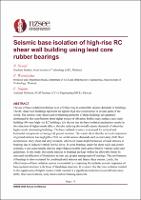| dc.description.abstract | The use of base isolation technique is an effective way to control the seismic demands in buildings. The RC shear wall buildings represent the typical high-rise construction in several parts of the world. The seismic story shears and overturning moments of these buildings are generally dominated by the contributions from higher modes of vibration. In this study, using a case study building (40-story high-rise RC building), it is shown that the base isolation mechanism results in the reduction of higher-mode effects, thereby reducing the overall seismic demands of otherwise higher-mode dominating buildings. The base isolated structure is analysed for vertical and horizontal components of strong real ground motions. The results show that the vertical component of ground motions has negligible effect on lateral seismic demands such as inter-story drift, floor acceleration, story shear and story moment, whereas it causes high fluctuation of axial stresses in bearings due to induced vertical inertial force. In some bearings under the shear walls and corner columns, it can cause tensile stresses larger than allowable limits prescribed by various codes and guidelines. In this study, the tensile stresses in bearings are kept within the allowable limits by structural modification of foundation system and proper arrangement of bearings. The performance of bearings is also evaluated for combined axial stresses and lateral shear strains. Lastly, the effectiveness of base isolation system is evaluated by comparing the inelastic seismic responses of base-isolated structure with those of fixed-base structure. It is shown that the base isolation resulted in the suppression of higher modes which resulted in a significant reduction in overall inter-story drifts, floor accelerations, story shears and overturning moments. | |

